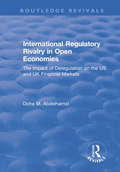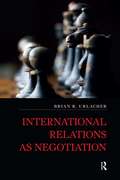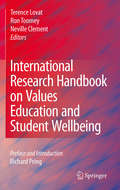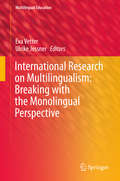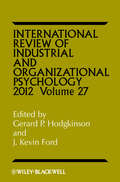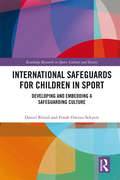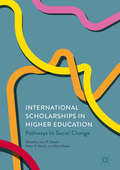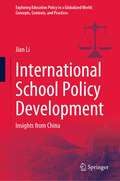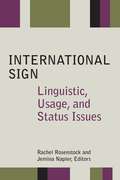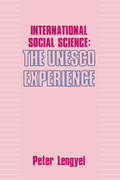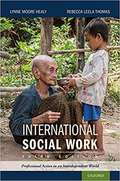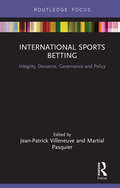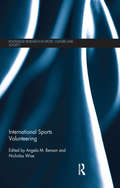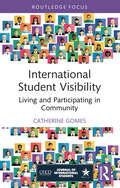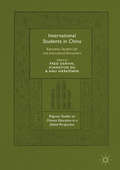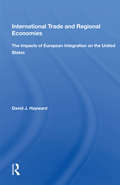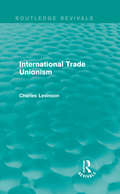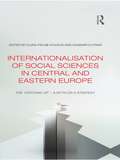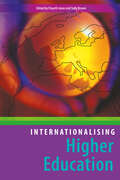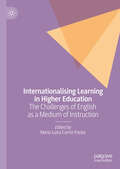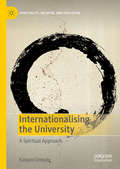- Table View
- List View
International Regulatory Rivalry in Open Economies: The Impact of Deregulation on the US and UK Financial Markets (Routledge Revivals)
by Doha M. AbdelhamidThis title was first published in 2003. This text aims to fill a gap in the literature for a text on the theory and practice of international regulatory competition in the open financial markets of the US and UK.
International Relations as Negotiation
by Brian R UrlacherNegotiations are central to the operation of the international system, found at the heart of every conflict and every act of cooperation. Negotiation is the primary vehicle that states use to manage conflict and build prosperity in a complicated and dangerous international system. International Relations as Negotiation provides an overview of world politics that is both approachable and detailed. It explores the factors that help or undermine efforts to negotiate solutions to international problems. Key topics including international conflict and security, the global economy, international law and governance, and environmental sustainability are explored in turn. The history of the international system is traced through major treaty agreements and peace conferences, and the future of the international system is projected. The result is a survey of world politics that provides a seamless narrative about conflict and cooperation in the international system.
International Research Handbook on Values Education and Student Wellbeing
by Terence Lovat Neville Clement Ron ToomeyInformed by the most up-to-date research from around the world, as well as examples of good practice, this handbook analyzes values education in the context of a range of school-based measures associated with student wellbeing. These include social, emotional, moral and spiritual growth - elements that seem to be present where intellectual advancement and academic achievement are being maximized. This text comes as 'values education' widens in scope from being concerned with morality, ethics, civics and citizenship to a broader definition synonymous with a holistic approach to education in general. This expanded purview is frequently described as pedagogy relating to 'values' and 'wellbeing'. This contemporary understanding of values education, or values and wellbeing pedagogy, fits well with recent neuroscience research. This has shown that notions of cognition, or intellect, are far more intertwined with social and emotional growth than earlier educational paradigms have allowed for. In other words, the best laid plans about the technical aspects of pedagogy are bound to fail unless the growth of the whole person - social, emotional, moral, spiritual and intellectual, is the pedagogical target. Teachers and educationalists will find that this handbook provides evidence, culled from both research and practice, of the beneficial effects of such a 'values and wellbeing' pedagogy.
International Research on Multilingualism: Breaking with the Monolingual Perspective (Multilingual Education #35)
by Eva Vetter Ulrike JessnerThis volume contributes to a better understanding of both psycho- and sociolinguistic levels of multilingualism and their interplay in development and use. The chapters stem from an international group of specialists in multilingualism with chapters from Austria, Canada, Germany, Hungary, Israel, Italy, Slovakia, South Africa, Spain and the United States. The chapters provide an update on research on third language acquisition and multilingualism, and pay particular attention to new research concepts and the exploration of contact phenomena such as transfer and language learning strategies in diverse language contact scenarios. Concepts covered include dominant language constellations, mother tongue, germination factors and communicative competence in national contexts. Multilingual use as described and applied in the volume aims at demonstrating and identifying current and future challenges for research on third language acquisition and multilingualism. The third languages in focus include widely and less widely used official, minority and migrant languages in instructed and/or natural contexts, including Albanian, Arabic, Basque, English, French, German, Hungarian, Italian, Romanian, Spanish, Punjabi, Russian, Turkish, and Vietnamese, thereby mapping a high variety of language constellations.
International Review of Industrial and Organizational Psychology 2012 (International Review of Industrial and Organizational Psychology #27)
by J. Kevin Ford Gerard P. HodgkinsonContinuing the series' tradition of providing scholarly reviews and updates of theory and research, this twenty-seventh volume surveys developments in established areas, such as stress and well-being, consumer behavior, and employee trust, as well as newer topics such as methodological issues in the development and evaluation of multiple regression models, and an examination of the psychological impact of the physical office environment. For advanced students, academics and researchers, as well as professionals, this is the most authoritative and current guide to new developments and established knowledge in the field.
International Review of Industrial and Organizational Psychology, 2012
by J. Kevin Ford Gerard P. HodgkinsonContinuing the series' tradition of providing scholarly reviews and updates of theory and research, this twenty-seventh volume surveys developments in established areas, such as stress and well-being, consumer behavior, and employee trust, as well as newer topics such as methodological issues in the development and evaluation of multiple regression models, and an examination of the psychological impact of the physical office environment. For advanced students, academics and researchers, as well as professionals, this is the most authoritative and current guide to new developments and established knowledge in the field.
International Safeguards for Children in Sport: Developing and Embedding a Safeguarding Culture (Routledge Research in Sport, Culture and Society)
by Daniel Rhind Frank Owusu-SekyereSafeguarding should be a central concern for any sports organisation working with children or young people. This significant new study examines the development, implementation and impact of the International Safeguards for Children in Sport; a set of guidelines drawn up by a working group of international organisations committed to child protection which lays out the measures that need to be taken to ensure children are kept safe from harm. Including critical perspectives and in-depth real-life case studies, this book looks beyond perpetrator, victim and abuse to focus on the development of a systematic safeguarding culture. The first study to adopt a global perspective on safeguarding in sport, it draws on the insights of researchers and practitioners to discuss best practise for child welfare, organisational reform, policy implementation and directions for future research. International Safeguards for Children in Sport: Developing and Embedding a Safeguarding Culture is important reading for all those working directly with children through the provision of sport in schools and communities, as well as for students and researchers of the sociology of sport.
International Scholarships in Higher Education
by Joan R. Dassin Robin R. Marsh Matt MawerThis book explores the multiple pathways from scholarships for international study to positive social change. Bringing together studies from academic researchers, evaluators and program designers and policymakers from Africa, Asia, Latin and North America, Europe, and Australia, the book compiles the latest research and analysis on the policy, practice, and outcomes of international scholarship programs. Contributions examine the broad trends in sponsored overseas study, program design considerations, the dynamics of the immediate post-scholarship period and the impact of scholarships on international education and development. Particular attention is focused on assessment and evaluation, the complexities of selecting awardees, the dynamics of returning home and concerns about brain drain and the state of knowledge and research on long-term outcomes of international scholarships with social change aims. nt>
International School Policy Development: Insights from China (Exploring Education Policy in a Globalized World: Concepts, Contexts, and Practices)
by Jian LiThis book investigates the international school policy reform in China from various perspectives. In recent years, international schools, international classes, international departments, and various international education projects have emerged in the field of education in China. This book explores and analyzes the idea of international schools, and discusses different aspects of the conceptual model of international education policy development in China, including international school policy, student cultivation, teacher cultivation, school management, curriculum, and quality assessment of international schools. In addition, this book offers a comprehensive, systematic, and practical perspective on shaping China’s international school policy development and management. This book serves as a guide for scholars and researchers who are interested, and work in, research on internationalization development in China, administrators, and stakeholders in China's education system, and graduate students who major or minor in the field of internationalization development in China.
International Sign: Linguistic, Usage, and Status Issues
by Jemina Napier Rachel RosenstockInternational Sign (IS) is widely used among deaf people and interpreters at international events, but what exactly is it, what are its linguistic features, where does its lexicon come from, and how is it used at interpreted events? This groundbreaking collection is the first volume to provide answers to these questions. Editors Rachel Rosenstock and Jemina Napier have assembled an international group of renowned linguists and interpreters to examine various aspects of International Sign. Their contributions are divided into three parts: International Sign as a Linguistic System; International Sign in Action—Interpreting, Translation, and Teaching; and International Sign Policy and Language Planning. The chapters cover a range of topics, including the morphosyntactic and discursive structures of interpreted IS, the interplay between conventional linguistic elements and nonconventional gestural elements in IS discourse, how deaf signers who use different signed languages establish communication, Deaf/hearing IS interpreting teams and how they sign depicting verbs, how best to teach foundation-level IS skills, strategies used by IS interpreters when interpreting from IS into English, and explorations of the best ways to prepare interpreters for international events. The work of the editors and contributors in this volume makes International Sign the most comprehensive, research-based analysis of a young but growing field in linguistics and interpretation.
International Social Science: Unesco Experience
by Perter LengyelFirst Published in 2017. Routledge is an imprint of Taylor & Francis, an Informa company.
International Social Work: Professional Action In An Interdependent World
by Lynne Moore Healy Rebecca Leela ThomasInternational Social Work: Professional Action in an Interdependent World, Third Edition, is a comprehensive treatment of all dimensions of international social work. The authors' four-part framework includes domestic practice and policy influenced by global forces, professional exchange, international practice, and global social policy. The first section of the book explores globalization, development and human rights as foundational concepts for international social work. The text then provides an overview of global social issues and international organizations related to social welfare. Part II offers an overview of the global history of the profession. Similarities and differences in social work around the world are examined through seven country examples. Part III provides an extensive discussion of current aspects of the global profession, with chapters on ethics, social policy, international development practice, and practice at the international/domestic interface. Modalities of international professional exchange are then explored prior to a concluding chapter that provides recommendations for international action. The text is enlivened by numerous case examples, drawn from many parts of the world. The history chapters include brief biographies of noted social workers on the international scene whose accomplishments serve as inspiration for readers. The text is extensively referenced with updated professional literature and intergovernmental documents. Carefully selected items in the appendix expand the usefulness of the book.
International Sports Betting: Integrity, Deviance, Governance and Policy (Routledge Research in Sport Business and Management)
by Martial Pasquier Jean-Patrick VilleneuveSports betting has become a truly global phenomenon, facilitated by new communication technologies. As a result, the development of deviances, from match-fixing to money laundering, has accelerated. This new reality has numerous implications, for both the regulation of this billion-dollar industry and the very integrity of sport, sport financing and betting operations. Written by an international team of academic researchers and industry professionals, International Sports Betting explores the central concepts of integrity and deviance, governance and policy, as well as perennial issues linked to the gambling sector, such as regulatory responsibilities and the fight against gambling addiction. Unlike other treatments of the gambling industry, the book offers a multi-disciplinary sociological and managerial critique that goes beyond a traditional focus on law and regulation. This is fascinating reading for any student, researcher or practitioner working in the areas of sport business, international business, international regulation, policy studies or gambling studies.
International Sports Volunteering (Routledge Research in Sport, Culture and Society)
by Nicholas Wise Angela M. BensonSport volunteering is becoming an increasingly popular motive for international travel. Many tourism organisations now advertise sport volunteering projects, with colleges and universities also offering students the opportunity to participate in similar projects abroad. This is the first book to bring together diverse and interdisciplinary insights into the development of the contemporary sport volunteering phenomenon. It addresses conceptual uncertainties and challenges emerging from the growing international sport volunteering market, and offers insight into its future directions, impact and sustainability. Drawing on both quantitative and qualitative methodologies, Part I examines volunteering in the context of international sporting events, while Part II evaluates volunteering initiatives related to sport development. Including case studies from Australia, Cameroon, Namibia, Norway, Russia, the UK, the US and Zambia, this substantial volume provides a truly international perspective on the changing roles of sport volunteering. Showcasing the latest research from across the globe, International Sports Volunteering is a valuable resource for any course on sport studies, sport event management, sport development, sport tourism, sport geography, the sociology of sport or leisure studies.
International Student Mobility and Transnational Friendships
by Basak BilecenFriends play a crucial role in international students' lives. This book explores the characteristics of the friendship networks of international doctoral students by analysing the relationships between these students and their friends, both in the country of education and across several national borders.
International Student Visibility: Living and Participating in Community (Routledge Studies in Global Student Mobility)
by Catherine GomesThis book narrates the ubiquitous relationship that international students have with their destination community, asking why students are not part of these communities despite being visible actors not only as students but as neighbours and as workers in the service industries and the gig economy.This book examines international students living and working in Australia through a cultural and communications lens, bringing together almost a decade of interviews and online surveys. It provides insight into their transnational identities and social and cultural practices in real-world and digital spaces. Despite being an integral part of the ethnographic landscape of the places they occupy, this book argues that international students are often not an integrated part of the wider community. To remedy this, international students have found ways to explore and communicate their experiences as transient migrants in Australia. This book thus goes beyond canonical academic commentary on the international student experience – which often views them as vulnerable migrants – to suggest that students create a sense of community and belonging while providing the wider Australian public insights into the international student experience through the creative arts.This book will appeal to scholars, upper-level students, and researchers with interests in international and comparative education, sociology of education, urban education, cultural studies, migration studies, and youth studies.
International Students in China: Education, Student Life and Intercultural Encounters (Palgrave Studies on Chinese Education in a Global Perspective)
by Fred Dervin Xiangyun Du Anu HärkönenAs the number of international students in Chinese higher education increases steadily, this volume is one of the first to focus on their many and varied experiences. With contributions focusing on such topics as intercultural adaptation, soft power and interculturality, language learning strategies and the intercultural, and transformations in perspective, this volume provides the reader with a broad overview of the latest advances in the field of interculturality and study abroad. While the book will appeal to a global audience of researchers, practitioners and students with an interest in Chinese higher education, it will also be of interest to all those who remain intrigued by conceptual and methodological issues of interculturality.
International Teachers’ Lived Experiences: Examining Internationalised Schooling in Shanghai (International and Development Education)
by Adam PooleThis book explores the emerging and under-researched phenomenon of internationalised schooling in China. It focuses on a group of “accidental” teachers who fell into teaching through happenstance or necessity, a group of teachers increasingly seeking refuge in Chinese Internationalised Schools. Chinese Internationalised Schools cater to an affluent middle class in China, offering some form of international curriculum which is taught by host country Chinese nationals and expatriate teachers. Chapters focus on three dimensions of teachers’ lived experiences of working in these schools: the intercultural, which explores teachers’ negotiations of intercultural teacher identities; the precarious, which highlights the struggles they might face at work; and the resilient, which illustrates how teachers survive—and even thrive—in the position. The author identifies a complex interplay between surviving and thriving, giving rise to the concept of “sur-thrival.”
International Trade And Regional Economies: The Impacts Of European Integration On The United States
by David J. HaywardThis book considers the issue of regional exposure to external economic events, exploring the role of trade in the performance of American states. It focuses on the case of trade with the European Community, analyzing the potential impacts of its integration on trade with individual states. .
International Trade Unionism: International Trade Unionism (Routledge Revivals)
by Charles LevinsonAs Secretary General of the ICF and previously Assistant General Secretary of the IMF, Charles Levinson played an important part in developing the countervailing labour response to the multinational corporations. His earlier work, Capital, Inflation and the Multinationals (Routledge Revivals, 2013) displayed the force of his insight into the dynamics of modern economics and technology. First published in 1972, this book considers the opportunities which allow unions to command an increasing share in decisions that shape the worker’s destiny. Chapters include discussions on the multinational corporations, industrial democracy and the ideas behind collective bargaining.
Internationalisation of Social Sciences in Central and Eastern Europe: The ‘Catching Up’ -- A Myth or a Strategy? (Studies in European Sociology)
by Dagmar Kutsar Ilona Pálné KovácsInternationalisation of Social Sciences in Central and Eastern Europe explores the way in which social sciences, in comparison with other sciences in Europe, have been divided by the political orders of West and East. As part of the field of science policies in Europe, this book contributes to the creation of a new understanding of the European academic landscape of social sciences with particular focus on CEE countries. In its investigation of the emergence of social sciences in Central and Eastern Europe following the collapse of the totalitarian systems, this book discusses how the internationalisation of the social sciences and the convergence between Western and Eastern social scientific life is hindered by factors including funding, academic contacts, and curriculum development. The issues addressed within the text serve to prompt the realisation that coherence in European social sciences can be reached only if new academic traditions and cultures are developed, and science policies harmonised. This book is essential reading for undergraduate and graduate students of European Integration, CEE or Transitional Studies, and any courses related to science policies. It is also relevant to science administrators and policy makers at national and European level.
Internationalising Higher Education
by Sally Brown Elspeth JonesWith increasing numbers of international students, this book explores how best to broaden the approaches to learning and teaching in the higher/further education environment. Rather than seeing internationalization as a problem to be addressed, this text embraces the opportunities for the enrichment of the learning environment through a values-driven approach to internationalization. Taking a positive and practical approach to internationalizing higher education, the book considers a range of questions about how to bring in global perspectives to the learning environment and education provision. Packed with case studies and vignettes from around the globe, the book proposes that the international student lies at the heart of the university as a source of cultural capital and intentional diversity, enriching the learning experience, enhancing staff experience and building a more powerful learning community.
Internationalising Learning in Higher Education: The Challenges of English as a Medium of Instruction
by María Luisa Carrió-PastorThis edited book examines the use of English as a Medium of Instruction (EMI) in a variety of international higher education contexts. The internationalization of education – indicated by increasing mobility of students, staff and ideas, as well as by policies and programmes put in place to facilitate educational exchange - has led to increasing adoption of English as a Lingua Franca (ELF) for educational purposes. In this book, the authors present the results of empirical research into the implementation, assessment, development and use of EMI programmes in different settings, presenting the case for more structured training of teachers and staff. It will be of interest to second/foreign language teaching and administrative staff, as well as anyone else involved in teaching in English at higher education level.
Internationalising the University: A Spiritual Approach (Spirituality, Religion, and Education)
by Kalyani UnkuleThis book takes a critical look at the internationalisation of higher education and argues for the importance of grounding education in spiritual perspectives. Using spiritual traditions to review the practices, programmes, and philosophies of learning that internationalise universities, the author proposes a paradigm for internationalisation that respects other ways of knowing. This focus seeks to decolonize knowledge and promote intercultural understanding, as well as help students achieve holistic personal development while studying abroad.
Internationalism or Extinction (Universalizing Resistance)
by Noam ChomskyIn his new book, Noam Chomsky writes cogently about the threats to planetary survival that are of growing alarm today. The prospect of human extinction emerged after World War II, the dawn of a new era scientists now term the Anthropocene. Chomsky uniquely traces the duality of existential threats from nuclear weapons and from climate change—including how the concerns emerged and evolved, and how the threats can interact with one another. The introduction and accompanying interviews place these dual threats in a framework of unprecedented corporate global power which has overtaken nation states’ ability to control the future and preserve the planet. Chomsky argues for the urgency of international climate and arms agreements, showing how global popular movements are mobilizing to force governments to meet this unprecedented challenge to civilization’s survival.
